Do you love or hate hydrangeas? The facts vs the myths
Hydrangeas are a flower that is both adored and deplored.
Naomi Slade has written a beautiful and definitive guide, called Hydrangeas (published by Pavilion Books). She says: ‘They’re so familiar, but people don’t actually know them as well as they think they do’.
I asked her for the facts and the myths on such issues as ‘how to turn my hydrangea blue, which hydrangeas are best for shade or sun and will a climbing hydrangea damage my wall?’
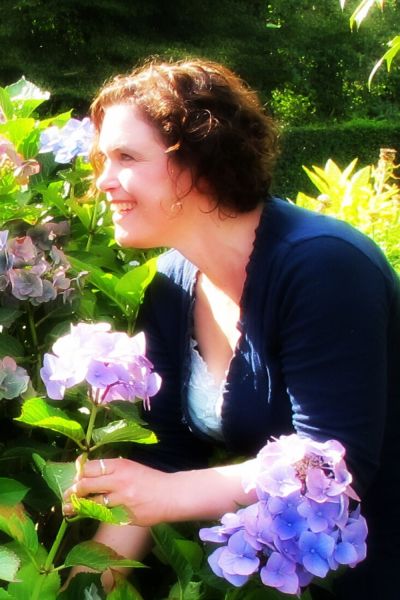
Naomi Slade, photo by Chris Wlaznik
Why hydrangeas?
Hydrangeas start to flower in mid-summer, often maintaining their silhouette as they age and antique, until the winter frosts. As a flower, they add months of seasonal interest to our gardens, and they do well in shade.
There are not many plants that can offer so much variety, colour and presence in our gardens for so long.
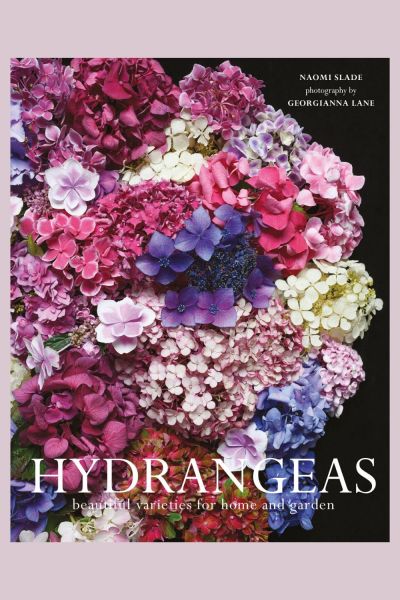
Hydrangeas is a gloriously illustrated book, as well as being packed full of interesting info about different types of hydrangea and their care.
A very British problem…
Disliking hydrangeas is a peculiarly British problem. If you put #hydrangea into Instagram, you will find stunning pictures of New England gardens with brilliant blue hydrangea hedges.
And there will also be delicately arranged hydrangea floral compositions from Japan, where hydrangeas are almost as revered as cherries. In Northern France, you will see chic hydrangea arrangements everywhere.
One of my most popular videos on the Middlesized Garden YouTube channel is about choosing and caring for hydrangeas. Yet when I look at who is watching it, only 15% of the viewers are from the UK.
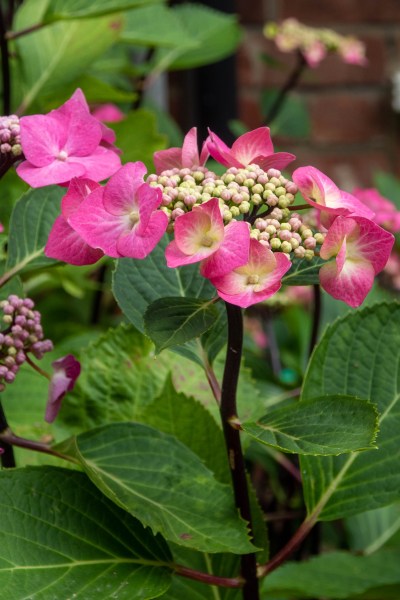
Hydrangea macrophylla – probably ‘Abracadabra Star.’ I love its black stems although a garden designer once told me that they were considered tasteless…is that more hydrangea snobbery? What do you think?
Naomi herself is a convert to hydrangea love. ‘I used to think they were big lumpy things,’ she says. ‘But I think you begin to understand the nuances of a plant as you get more adept as a gardener.’
In the book, she also suggests that ‘most hydrangeas in the UK were bred for the pot plant market and they didn’t always perform when transferred to a garden.’
The main answer to your questions…
Almost every question you ask about hydrangeas can be answered if you know what kind you have.
Which is why Naomi’s Hydrangeas is an invaluable – as well as beautiful – source of hydrangea advice. As well as explaining 50 different varieties, with gorgeous photographs by Georgianna Lane, she also explains how to choose and care for these amazingly long-season plants.
The book lays out the history of how the plant came to be in our gardens in a most readable and entertaining way. And understanding where a plant has come from helps enormously when you come to grow it in your own garden.
Discovered by eighteenth century plant hunters in the Americas, China and elsewhere in Asia, the story of the hydrangea reads like a thriller. First brought to Europe from the Americas in 1736, hydrangea cuttings were also smuggled out of the highly secretive 19th century Japan by early botanists, one of whom had to acquire a pet goat in order to justify his plant hunting.
The different hydrangea types…
Check the label when buying a hydrangea. You don’t need to be able to remember the botanical names, but it’s very useful to have a record of them when choosing, pruning or caring for them.
If you have had hydrangeas in the garden for years, and don’t know what kind it is, then the flower and leaf shape will tell you which is which.
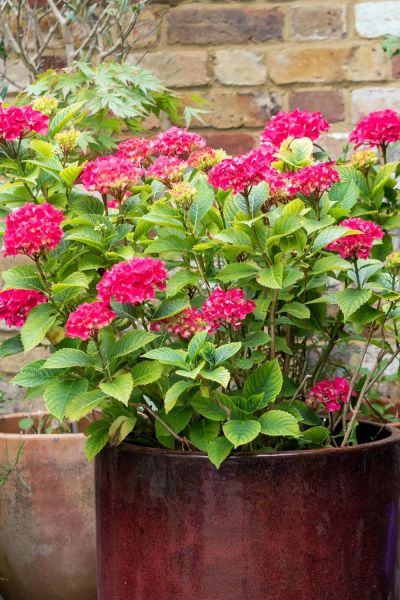
Hydrangeas also do well in pots – this is (probably) Hydrangea macrophylla ‘Hot Red’. The bigger the pot, the better!
Mop-heads and lace caps…
The hydrangeas you are most likely to find in your garden or garden centre are macrophylla, which divide into mop-heads and lacecaps. If you are a hydrangea hater, it’s likely that your disdain is directed at the mop heads.
Macrophyllas are the ones which can change colour from pink to blue, depending on your soil.
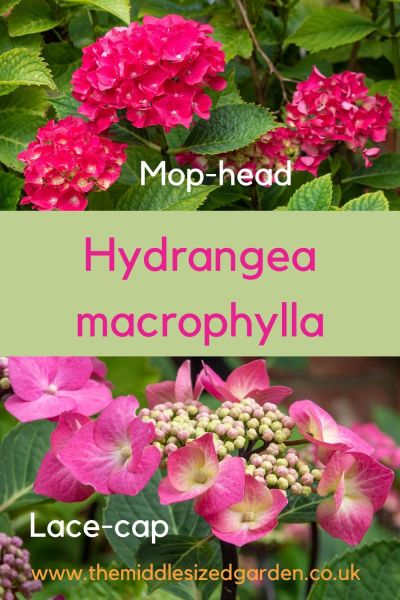
It’s easy to spot the difference between ‘mop head’ and ‘lace cap’ hydrangeas.
Arborescens, paniculata and oak-leafed…
The hydrangeas that are most fashionable in the UK today are Hydrangea arborescens and Hydrangea paniculata. These both originate in North America and are still very popular there.
Arborescens and paniculata don’t change colour, ‘although they may turn antique shades as they age,’ says Naomi.
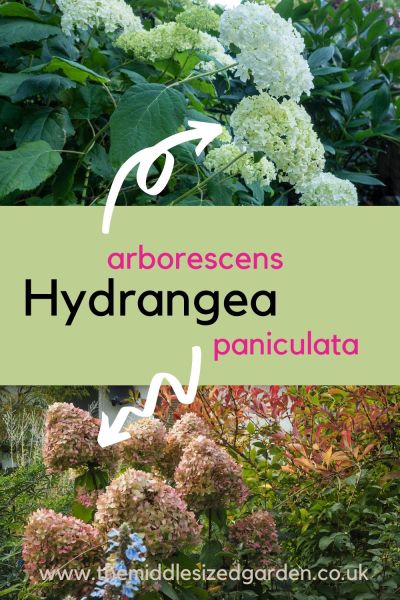
Hydrangea arborescens ‘Annabelle’ and Hydrangea paniculata ‘Vanilla Fraise.’
And then there’s Hydrangea quercifolia or Oak-leafed Hydrangea. It’s the easiest one to spot because its leaves are like oak leaves.

And the climbing hydrangeas…
The other type you will find commonly is the climbing hydrangea, which is either Hydrangea petiolaris or Hydrangea serratifolia.
Botanists believe there are still many hydrangea varieties, growing undiscovered, especially in South America.
There’s more about choosing these beautiful plants in my interview with Signature Hydrangeas.
How can I make my hydrangea go blue?
The internet is awash with suggestions on how to turn your pink hydrangeas blue. However, many veer towards myths rather than facts.

To get a blue hydrangea, buy a blue hydrangea and plant it in acid soil or in a pot with ericaceous compost! That is the only sure-fire technique that has proved to work.
Firstly, you need to have the right type of hydrangea – a macrophylla. Then it’s down to your soil.
‘Coloured hydrangeas are pink in alkaline soil and blue in acid soil because the presence of lime locks up the Aluminium ions that are required for making the blue pigment,’ explains Naomi. ‘So it is not actually the pH of your soil as much as the composition of the nutrients that the plant can access.’
She says it is possible to slightly change the pH of your soil.
‘But it is not easy, particularly in open soil. People talk about surrounding a plant with ‘acidifying’ coffee grounds or citrus peel, but I’d personally be cautious.
You would need a lot of coffee or lemon peel to make a difference. And that difference would only be temporary. Plus too much of anything carries the risk of damaging your garden plants, too.’
If you want blue hydrangeas, it’s much easier to grow them in a pot, she advises.
Use a suitable growing medium, such as ericaceous compost, such as Melcourt Sylvagrow ericaceous compost. And feed with an ericaceous plant food, such as Empathy After Plant Ericaceous feed. (Note: links to Amazon are affiliate, so I may get a small fee if you buy but it won’t affect the price you pay. I only recommend brands I know and like.)
Which hydrangeas are the best for bees and other wildlife?
‘The big florets on a hydrangea flower head are made up of sterile bracts,’ says Naomi. ‘These are just there for show and don’t carry any pollen or nectar.’
So mop-head hydrangeas, which only have the big florets, are no good for bees.
‘But lacecap hydrangeas have little, fluffy fertile flowers in the middle, which do have pollen for insects,’ she says. So lacecap hydrangeas are much better than mopheads for pollinators.
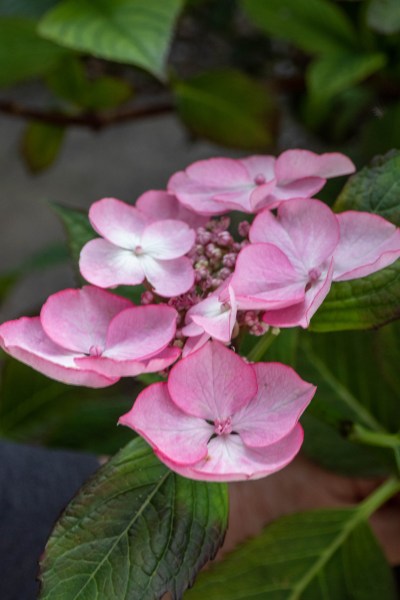
It’s the tiny fertile flowers at the centre of a lace cap hydrangea that are good for pollinators. The showy ‘petals’ around the outside are just sterile bracts, says Naomi.
‘And if you choose climbing varieties such as Hydrangea petiolaris or Hydrangea serratifolia, they can also create nesting spots for birds and places to hibernate for insects,’ adds Naomi.
Will a climbing hydrangea damage brick?
Many people fear that any climbing plant will damage their house’s brickwork. But there’s no evidence that these aerial suckers damage brick. However, Naomi points out that they may penetrate damaged mortar.
‘Although it could be argued that if the mortar is already crumbling to that extent, the problem might be the wall, not the hydrangea! Most houses will be equal to the task of supporting the plant, but it can be worth pruning around window frames and gutters to make sure that wandering stems don’t try to find their way in.’
Which hydrangeas are best for shade?
Naomi says that Hydrangea macrophylla is best for shade. ‘I prefer cultivars with white flowers such as ‘Dancing Snow’ or classic ‘Lanarth White’ to brighten the gloom. Macrophylla is thirsty and damp-tolerant but in sun they will need a lot of water. Hydrangea serrata is also versatile, and more cold-resistant too.’
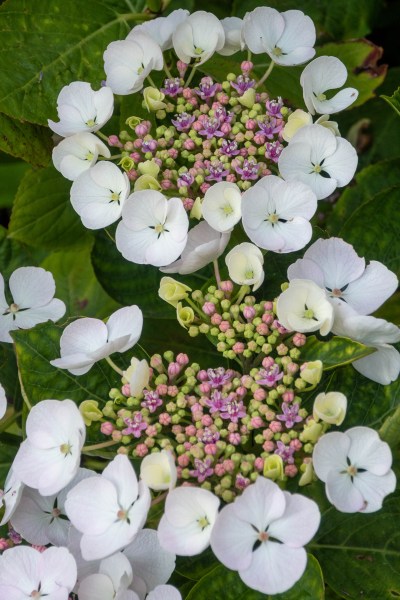
This is an unknown ‘lace cap’ Hydrangea macrophylla in my garden. It does well on a shady North-facing wall.
Which hydrangea is best for sun?
Hydrangea quercifolia (Oak leafed hydrangea) does best with plenty of warmth and sunshine. It won’t be happy in the shade, says Naomi.
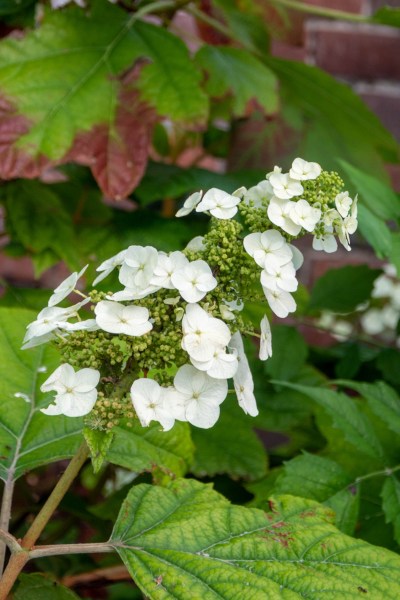
Oak leafed hydrangeas do well in sunny spots.
Which plants work best with hydrangeas?
If planting hydrangeas in a border, she suggests partnering them with plants that have an opposite season of interest, such as azaleas.
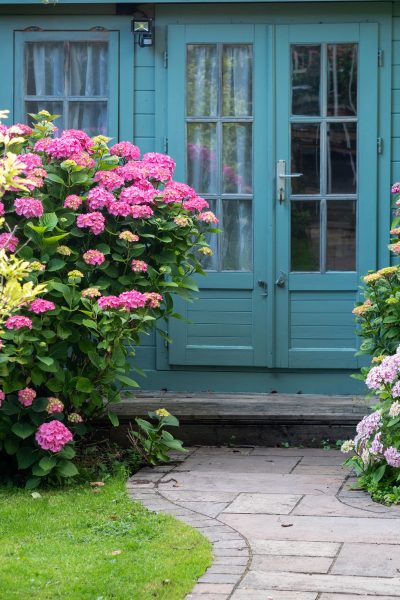
Two large clumps of hydrangeas flank the entrance to Emma’s shed, creating a striking presence from mid-summer to late autumn. Hydrangeas grown in groups are very effective.
More about Hydrangeas…
Hydrangeas are easy to care for, but they do need pruning once a year. See our really simple guide to pruning hydrangeas.
Signed copies of Hydrangeas by Naomi Slade are available directly from Naomislade.com. There are more buying options from Pavilion Books and also via Amazon.
This beautiful book covers the history of hydrangeas, plus how to choose and care for them, including how to propagate and prune. The photographs by Georgianna Lane, are stunning. It’s a highly enjoyable read, as well as a very useful practical handbook, and it would also make a good gift.
And dahlias…
Naomi Slade and Georgianna Lane worked together on an equally beautiful and informative book called ‘Dahlias’. Both books are on my ‘Good books on plants’ list on the Middlesized Garden Amazon Store.
I’m often asked for recommendations, so I have created lists of gardening products, books and tools I use myself, such as Essential Gardening Tools. I’ve either bought these products or have been sent them for review, but I only include them in the lists if I have used them and believe you will like them as much as I do.
Pin to remember ‘Hydrangeas’
And do join us every Sunday morning on the Middlesized Garden blog. See here for how to follow by email.
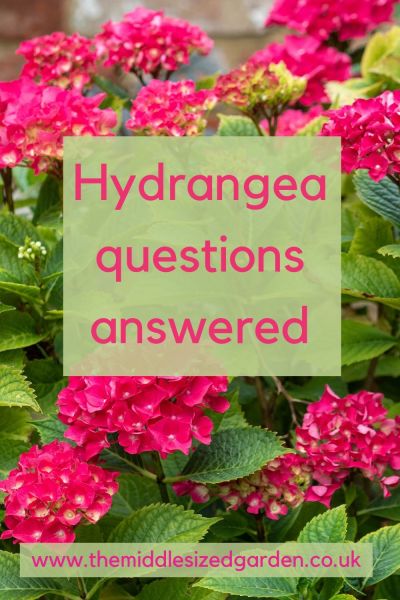
























I love hydrangeas! I have two banks of Annabelle planted with English Lavender. At the moment, they look fabulous- impactful yet restful. The colours mix so beautifully.
That does sound beautiful.
Thank you for another great post & video.
I was disappointed that I did not find out why my hydrangea is not blooming if it hasn’t been pruned? I have struggled with growing them between the very hot dry summers where I live & the deer, who love to eat them.
I think I’ve finally found a good shady spot to protect them from the harsh summer heat & the deer but they are not blooming & I have not pruned them. My plant is still very small, only two years old at this point.
I have just interviewed Neil Miller, the head gardener at Hever Castle and although we were talking about roses, I asked him about your hydrangea. He says that if the plant has never bloomed, then there may be something wrong with it, but he would recommend feeding it with a fertiliser suitable for shrubs and seeing whether that helps. Flowering plants usually need a phosphorus-based fertiliser to increase blooms – traditional ‘fish,blood and bone’ should be fine or any fertiliser that says it increases blooms and is suitable for shrubs. Hope that helps!